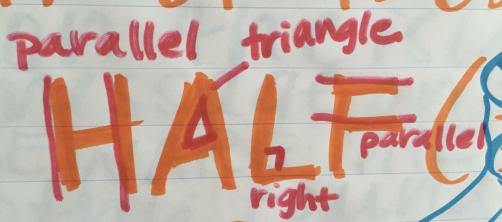This was a 4-day week at school, but since we’ve moved our MWU to the afternoon (instead of first thing in the morning), it has seemed it’s been easier to make them happen every day. Maybe it’s just because of the unit we’re in, too, but our conversations about them have been SUPER POWERFUL lately. Can’t imagine teaching without this part of our day!
Monday
I definitely should have taken a before and after picture of this one. The circles were all filled up with post-its when we sat down to talk, but we had to work through them and decide which ones sounded like things mathematicians would say about these polygons. Many of them were vague or didn’t use mathematical terms. They said things like “they’re different” or “they’re the same.” We talked through the definition of polygon (hence the words over there) as well as what some mathematical terms were that we should listen for as we narrowed down the choices. This idea of comparing is something that students are expected to know how to do independently with two different polygons by the end of the unit, so trying some together along the way was crucial.

Tuesday
This one matches up with both some work on shapes we had done earlier (names and attributes), as well as a replay of the question from the day before to see how they’d do in the same situation with different shapes. The number of specific, mathematical responses was much greater this time and we had less work to do to make our Venn Diagram make sense.

Wednesday
This question has a great story to tell (which is SO long and involved I’ll be nice and put it in a different post!), and really gave us lots of math to chew on. And I thought I would be an easy one. Those are always the problems that surprise me.

Do you see the marks on the word HALF up there? Here’s a close-up:

We’re applying our knowledge of lines, angles and polygons everywhere we look! This wasn’t even part of the question, but of course was a great part of the discussion!
Thursday
After all our hard work (which I hope you’ll pop over and read about), I wanted to see if they could remember and apply it to a similar but new situation. Most could see how the knowledge we had gained the day before about halves applied to thirds (and therefore to fourths, fifths, sixths, etc.).

What did you work on as a mathematician this week? What warm-ups would you suggest to us that include angles, polygons or fractions? We’d love to try some more! 🙂
